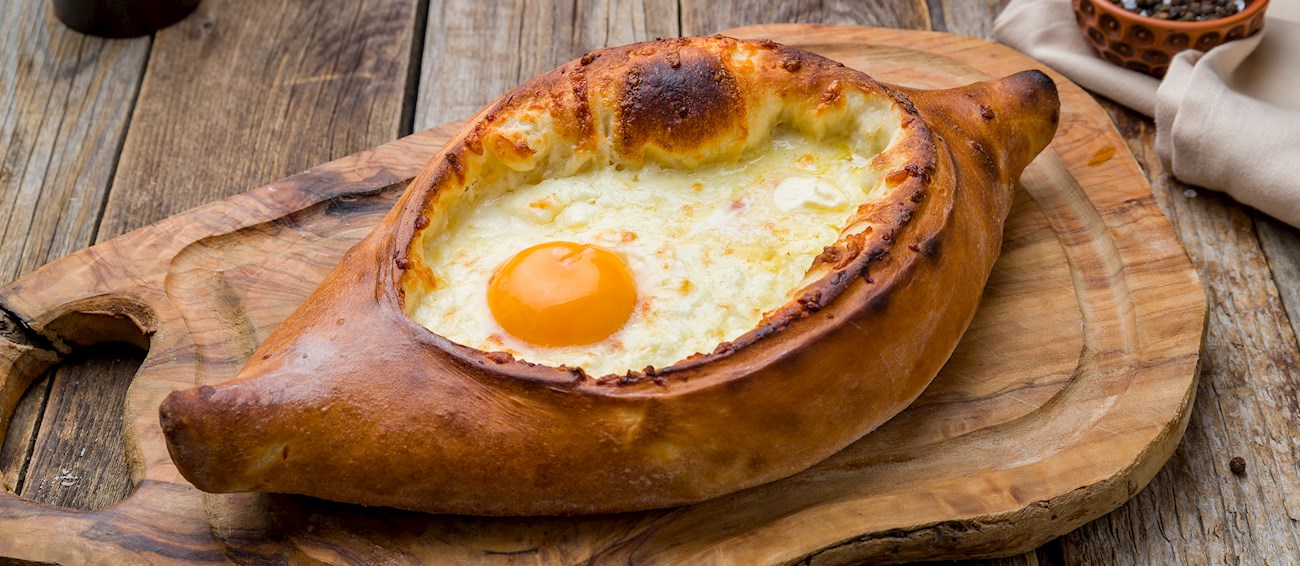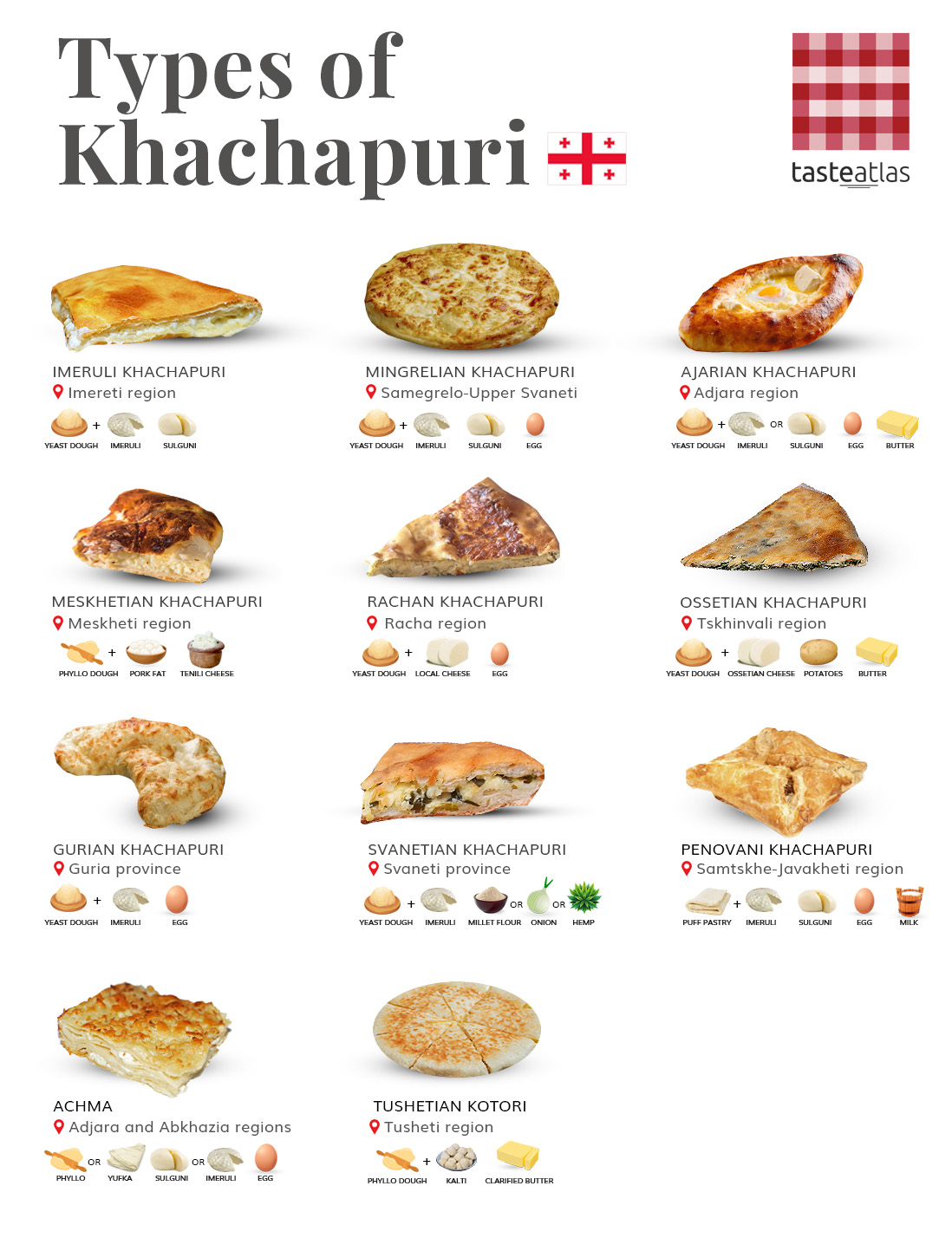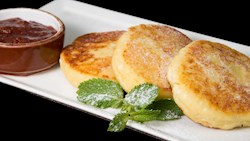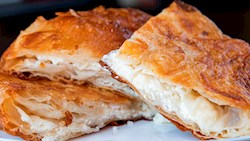Belmuž is a traditional shepherd's dish originating from eastern Serbia. This simple dish consists of only three ingredients – cheese, flour, and a bit of salt. The key ingredient is cheese, that should be fresh and full-fat cow's or preferably sheep's cheese.
Once cut into pieces, the cheese is placed in a big pot over low heat. As it melts, salt and flour are added until a homogenous mass is formed. The mixture is continuously stirred with a big wooden spoon until the fat separates and starts to float on the surface.
MAIN INGREDIENTS
This simple cheese bread known as khachapuri is the most famous dish in Georgia. It is traditionally topped with melted cheese, eggs and butter. There are different types of khachapuri, and even though some new cheese varieties such as mozzarella and feta have been incorporated in the dish, the most common additions still include traditional Georgian Sulguni or Imeretian cheese.
It is shaped into different forms, and depending on the baking procedure and its form, it can be consumed individually or shared. Two of the most common varieties include the Imeretian khachapuri, shaped into a circular form, and Adjaran khachapuri, the open-faced version topped with butter and a raw egg on top.
VARIATIONS OF Khachapuri
MOST ICONIC Khachapuri
View moreMAIN INGREDIENTS
The Bulgarian pie banitsa made with cheese is the main version of this traditional pie. It's made by layering sheets of buttered phyllo pastry with a combination of eggs, yogurt, and cheese such as sirene and feta. There's an optional ingredient in the preparation of banitsa and it's baking soda, which makes the yogurt rise and makes the pie fluffier and richer in flavor.
Traditionally, banitsa with cheese was prepared and served on Christmas and New Year's Eve, but nowadays it can also be bought throughout the year at grocery stores, street vendors, kiosks, and pretty much everywhere. Apart from this basic variety, there are also other types of savory or sweet banitsa pies filled with various vegetables and fruits.
MAIN INGREDIENTS
Saganaki is a highly popular Greek appetizer where various vegetables, meats, or seafood such as shrimp or mussels are wrapped in cheese, then pan-fried or seared. The cheese can also be prepared on its own, without any accompaniments. It is then pan-seared until it develops its distinctive golden crust, and served in the so-called sagani, a small, two-handled pan in which it was fried.
In the past, the word saganaki referred to a method of spicing up the local cheese by Greek peasants, who would pan-fry different varieties of cheese such as feta, kashkaval or manori. While regional variations of the dish include the use of formaela cheese in Arachova and halloumi in Cyprus, the cheese used in a typical Greek saganaki is usually graviera, kefalograviera, kasseri, kefalotyri, sheep's milk feta or any other firm cheese that melts well without losing its shape.
MOST ICONIC Saganaki
View moreMAIN INGREDIENTS
In Argentina, provoleta or grilled provoleta cheese is typically enjoyed before a meal as an appetizer. It's one of the staples of the Argentine bbq asado. The semi-hard provolone is the perfect cheese for the grill, because it's compact and firm.
For asado, it is sliced about an inch thick, seasoned with a generous amount of oregano, maybe a light sprinkling of dried red chili flakes, and grilled until it just starts to melt in the center. Provoleta is best enjoyed topped with the garlicky chimichurri sauce and paired with crusty bread on the side.
MOST ICONIC Provoleta
View moreMAIN INGREDIENTS
One of the most popular khachapuri varieties, adjarian is an open-faced pie that is filled with a combination of cheese and eggs. The base is made from yeasted dough that is rolled into an oblong shape and traditionally comes filled with Sulguni or Imeretian cheese, or the combination of both.
The dish is finished off with an egg that is placed on top, and the pie is then additionally baked until the egg is partially set. This boat-shaped pie hails from the coastal Adjaria region, and it is usually served with a slice of butter on top.
MOST ICONIC Ajaruli khachapuri
View moreMAIN INGREDIENTS
This is another one of those centuries-old dishes that were invented as a practical way to use old cheese and old bread. In this case, the dish is called fondue jurassienne. The star of this fondue is Comté cheese, a staple in the Jura and Franche-Comté regions.
To make this cheesy fondue, highly acidic white wine is first warmed in a pan or a pot, and it is then combined with a combination of Comté cheese and cornflour until it is thoroughly combined with the wine. Kirsch, salt, and pepper are added to the whole combination, which is then transferred to a well-warmed, garlic-rubbed fondue pot set over a flame.
MAIN INGREDIENTS
Moitié-moitié (lit. half and half) is a traditional cheese fondue originating from Fribourg. The name refers to the fact that the fondue is made with equal amounts of Gruyère and Vacherin Fribourgeois cheese, along with garlic, white wine, potato starch, black pepper, and Kirsch.
The fondue pot is rubbed with garlic – the clove is left in the pot and mixed with all the other ingredients except the Kirsch and pepper. The ingredients are stirred until smooth and creamy. The mixture should not come to a boil, but it should be left to lightly simmer.
MAIN INGREDIENTS
This khachapuri variety hails from Guria, a province in the west of Georgia. Unlike other khachapuri pies, this one is crescent-shaped and it's prepared for Orthodox Christmas. The dough is filled with a combination of grated Imeruli cheese and hard-boiled eggs before it's baked until golden-brown.
The shape of this pie was associated with celestial bodies, and for ancient Gurians it was a symbol of strength, so nowadays there is a superstitious belief that each family member should get at least one Gurian khachapuri during the festive Christmas season.
Quesadilla is a simple Mexican snack consisting of a flour or corn tortilla filled with cheese that melts well. It is commonly folded in half and consumed. A quesadilla can also have some other ingredients on the inside such as meats, beans, or potatoes, but cheese is always mandatory (with the exception of Mexico City, where cheese in a quesadilla is often an afterthought).
Sometimes, it is cut into wedges and served with salsa or guacamole on the side, and it can be topped with vegetables such as diced tomatoes, onions, lettuce, or hot chiles. The origins of quesadilla are somewhat murky, but it is known that the cheese was brought to Mexico by the Spaniards along with other dairy products in colonial times, and the thin flatbreads were already a staple of the Mesoamerican people.
MOST ICONIC Quesadilla
View moreTasteAtlas food rankings are based on the ratings of the TasteAtlas audience, with a series of mechanisms that recognize real users and that ignore bot, nationalist or local patriotic ratings, and give additional value to the ratings of users that the system recognizes as knowledgeable. For the “Top 100 Cheese Dishes in the World” list until February 13, 2025, 13,539 ratings were recorded, of which 8,749 were recognized by the system as legitimate. TasteAtlas Rankings should not be seen as the final global conclusion about food. Their purpose is to promote excellent local foods, instill pride in traditional dishes, and arouse curiosity about dishes you haven’t tried.



























































































































